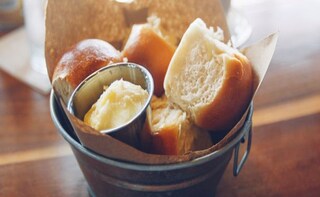The story of pav begins many years ago with the Portuguese invasion of Goa. The Portuguese residing in India missed their daily diet of bread and meat, although many adopted the dietary habits of the Goans. Lizzie Collingham in Curry: A Tale of Cooks and Conquerors tells us that visiting Portuguese from the homeland were startled to find the wives of the settlers eating a meal of rice, mango pickle and fish or meat cooked in gravy, all with their hands! Some of them even adopted the high Indian standards of hygiene - bathing every day and washing as often as possible, rather than slathering on clouds of perfume to conceal their smell, as was common in Europe in those days. But there was one thing that they missed terribly and that thing was bread, both for the taste and for the significance it had in their religious rituals.But how to procure the yeast that was necessary for baking bread? Such a thing was unheard of in India, at the time. In fact, it was the canny Goan cook who came to their rescue. "(The cooks) used toddy to ferment the dough, with...good results," writes Collingham. "In fact, the Portuguese added a variety of European breads - crusty white rolls...and the sweet milk bread called pao de lo - to the Indian repertoire."
Pav Makers in MumbaiEven today, some of the best pav makers in Mumbai are Goan or Irani. For instance, the Irani-owned Yazdani Bakery (named for the region of Yazd in Iran) prepares about 1,000 ladi pavs each day. Try the heavily buttered pavs with a cup of hot tea.Kyani's Bun Maska is a soft, pull-apart bun dipped into hot chai and eaten. Bandra's A1 Bakery is an unassuming stall with a thriving demand in pav and gutli pav (hard bread).Worli's City Bakery, born in 1953, is one of the city's mot iconic bakeries. It sells today, panoply of sweet treats such as cakes, Swiss rolls and doughnuts. But its beating heart is its pav, which is often sold out almost as soon as it hits the shelves.
Image credit: Istock/ Neha Aurangabadkar
Advertisement
Pav Makers in MumbaiEven today, some of the best pav makers in Mumbai are Goan or Irani. For instance, the Irani-owned Yazdani Bakery (named for the region of Yazd in Iran) prepares about 1,000 ladi pavs each day. Try the heavily buttered pavs with a cup of hot tea.Kyani's Bun Maska is a soft, pull-apart bun dipped into hot chai and eaten. Bandra's A1 Bakery is an unassuming stall with a thriving demand in pav and gutli pav (hard bread).Worli's City Bakery, born in 1953, is one of the city's mot iconic bakeries. It sells today, panoply of sweet treats such as cakes, Swiss rolls and doughnuts. But its beating heart is its pav, which is often sold out almost as soon as it hits the shelves.
Advertisement
Advertisement
Image credit: Istock/ Neha Aurangabadkar
Advertisement
For the latest food news, health tips and recipes, like us on Facebook or follow us on Twitter and YouTube.
Advertisement
